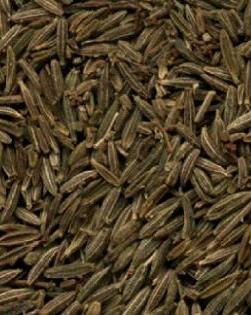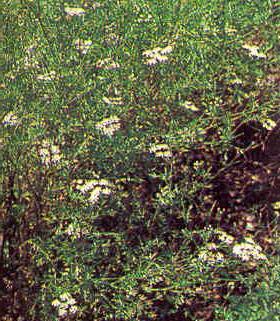Owing to the screen size of your device, you may obtain a better viewing experience by
rotating your device a quarter-turn (to get the so-called "panorama" screen view).
|
This page updated for 2022.
|
Click here for the site directory.
|
|
Please consider linking to this site!
|
Click here to email us.
|
Cumin
(Cuminum cyminum)
We believe, for the reasons set forth on the main Herbs directory page, that growing spice plants for seed is not wise gardening; but, for those who disagree, the information here should suffice.
About Cumin

Cumin is one of the flavorings most commonly mistaken for something else, or something else for it, owing to problems in translation from the languages of the lands where its use and cultivation are common. It is not much grown, even in home gardens, in the U.S., owing, we suppose, mainly to two factors: a belief that it cannot be grown outside tropical areas, and some uncertainty as to its culinary uses.
Cumin is especially frequently confused with caraway, which it also resembles physically (the “seeds”, that is—which are not truly seed but actually the fruit of the plant—not the plants). But while caraway can substitute for cumin in some dishes, for many others—in Indian and Mexican cooking, for example—it is essential to have actual cumin.
Cultivars

There are several plants that masquerade as cumin. True cumin is, biologically, Cuminum cyminum; the imposters include (at the least) Nigella sativa (“black cumin”); Cuminum nigrum aka Bunium persicum (“bitter cumin”); and an unspecified “relative of black cumin” (brown cumin). None of those will really substitute for true cumin, at least for those familiar with the cuisines in which cumin is commonly used.
Despite extant differences among cultivars (distinguished in those lands where cumin is grown commercially) in seed color, quantity of essential oil, and flavor, there do not appear to be any named varieties available in seedsmen’s catalogues. U.S. seedsmen need to get on the stick as pertains to herbs and spices, and stop offering generic “no-name” cultivars (or, more likely, unsorted mixes). The best one can say is just make absolutely sure that any cumin seeds you buy are 100% true Cuminum cyminum.
(Re the infamous “black cumin”: it is a fine illustration of the huge and frustrating problems with terminology with herbs and spices. The plant Nigella sativa, a member of the Ranunculaceae, the buttercup family, and quite unrelated to actual cumin, is commonly called, and sold as, “black cumin”; and just to add to the fun, other things it is commonly called—besides “black cumin”—are fennel flower and Roman coriander, despite it’s not being any kind of fennel or coriander. Incidentally, Nigella sativa is perhaps best known as the flower “Love in the Mist”, and is arguably worth growing as a flavoring in its own right. Oh, yes, there is also Bunium persicum, another quite unrelated plant also known as “black cumin”—what fun. Caveat emptor!)
Planting
Timing
Many sources casually assert that cumin cannot be reliably grown in the north, but it has been reported as reliably grown well into Manitoba (and Norway). It appears to be a matter of timing, the conventional (and doubtless sound) advice being “Sow seed in spring or early summer when all danger of frost is over and the soil has warmed up.” The plant is frost-tender, can take up to 4 months from seeding to harvest, and likes warm to hot growing weather.
None of that looks insuperable: if, in this climate, one sowa it in middle May, looking to a harvest in, at latest, middle September, one should be all right save in the freakiest of years.
Or, one can grow it indoors in a container (which should be pretty deep).
The Bed
The general rule for herb and spice plants is that their soil needs are not demanding, save that the soil must be very well-drained: few herb or spice plants can stand “wet feet”. The soil should not be particularly rich, most especially not for flavoring plants we grow for their seed (or fruit), common mis-advice to the contrary notwithstanding: a rich soil will lower the concentration of the “aromatic oils” that give the seed its characteristic flavor, which is the very thing we are growing them for. Plants that are very slightly nutrient-stressed (which doesn’t mean starved!) give better-tasting seed.
Cumin apparently fits that description excellently.
Planting Out
Be sure to plant a good number of “seeds”, no matter how many plants you think you need, because you need an at least moderate-sized stand of the plants to keep them more or less upright (otherwise the disproportionate weight of their seed heads bends them over). And even if you don’t have a deep-dug or raised-bed plot, try to plant your cumin in a block, not a row.
Sow the “seeds” about ¼ to ½ inch deep where the plants are to grow (like many herb and spice plants, coriander does not take well to transplanting). The plants should be spaced quite close together. Keep the soil well moistened till emergence, and even thereafter.
It would be wise to use row covers at least till all risk of frost is past—say to middle or even late June.
Growing
Let the seedlings stay quite close together, as that lets them support one another as their relatively heavy seed heads develop. Water very well: cumin likes a damp climate (but, as almost always with spices, not “wet feet”). Cumin is said to be “intolerant” of long periods of dry heat, of which we get our share around here; perhaps some misting would be wise in such periods.
The availability of honey bees as pollinators will usually improve cumin yields.
Cumin “seeds” notoriously ripen unevenly, so you need to keep a close eye on your crop and harvest plants individually, lest the heads shatter prematurely. Let each plant grow till its first set of seeds dries enough to crack when pinched (it can take up to 120 days to produce mature seed; at that time, cut the plant. Hang cut plants to dry over a catch-cloth; when they are thoroughly dry, dump them into a holding bag (which you will later use for threshing them).
When your crop is fully harvested, thresh the lot: beat the holding bag in which you have collected them against a hard surface to dislodge the seeds. Sift the loose seeds through a 3-inch mesh hardware cloth to remove the chaff. Make absolutely, positively sure the seeds are thoroughly dried before putting them away for storage (in the usual manner for dried herbs and spices: an airtight container stored in a dark place, preferably a cool one).
Relevant Links
Besides any links presented above on this page, the following ought to be especially helpful.
Return to the top of this page.
If you find this site interesting or useful, please link to it on your site by cutting and pasting this HTML:
The <a href="https://growingtaste.com/"><b>Growing Taste</b></a> Vegetable-Gardening Site
—Site Directory—
Search this site, or the web
-
Background Information
about the purposes and design of this site
- Site Front Page
-
Introduction

- An Apologia: why one should cultivate one's garden
- Deep-Bed Gardening (forthcoming)
- Container Gardening (forthcoming)
- Vegetarian and Organic Considerations (forthcoming)
-
Recommended Crops for a home garden, by variety
-
Gardening information and aids
-
Miscellaneous Information of interest to the home gardener
Since you're growing your own vegetables and fruits, shouldn't you be cooking them in the best way possible?
Visit The Induction Site to find out what that best way is!
|
If you like good-tasting food, perhaps you are interested in good-tasting wines as well?
Visit That Useful Wine Site for advice and recommendations for both novices and experts.
|

|
This site is one of The Owlcroft Company family of web sites. Please click on the link (or the owl)
to see a menu of our other diverse user-friendly, helpful sites.
|
|
 Like all our sites, this one is hosted at the highly regarded Pair Networks,
whom we strongly recommend. We invite you to click on the Pair link for more information on getting your site or sites hosted on a first-class service.
Like all our sites, this one is hosted at the highly regarded Pair Networks,
whom we strongly recommend. We invite you to click on the Pair link for more information on getting your site or sites hosted on a first-class service.
|
|
All Owlcroft systems run on Ubuntu Linux and we heartily recommend it to everyone—click on the link for more information.
|
Click here to send us email.
Because we believe in inter-operability, we have taken the trouble to assure that
this web page is 100% compliant with the World Wide Web Consortium's
XHTML Protocol v1.0 (Transitional).
You can click on the logo below to test this page!
You loaded this page on
Friday, 18 April 2025, at 18:59 EDT.
It was last modified on Sunday, 9 January 2022, at 19:38 EST.
All content copyright ©1999 - 2025 by
The Owlcroft Company


